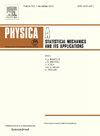Assignment of passenger flow in urban agglomerations via land transport channels considering competitive relationships
IF 3.1
3区 物理与天体物理
Q2 PHYSICS, MULTIDISCIPLINARY
Physica A: Statistical Mechanics and its Applications
Pub Date : 2025-06-20
DOI:10.1016/j.physa.2025.130785
引用次数: 0
Abstract
With the rapid advancement of urbanization, urban agglomerations have become the core carrier of regional economic development. To address the limitations associated with neglecting the competitive dynamics between intermodal transport systems in traffic assignment from an urban agglomeration perspective, this study proposes a novel traffic assignment method that integrates both road and railway networks while considering their competitive interactions. Firstly, an enhanced composite network model of highways and railways is established by refining the Space-L method. Subsequently, leveraging the principles of generalized cost theory and competition-cooperation theory, a network impedance model is developed to effectively assign passenger flows. Finally, missing data are inferred through OD reverse reasoning, enabling precise forecasting of future passenger flow distribution via network analysis. In the case of the Ha-Chang urban agglomeration, the proposed method achieved an average error rate of 4.93 %, compared to 9.44 % for the four-stage method. By providing accurate passenger flow forecasts, this approach facilitates policymakers in promoting coordinated development within urban agglomerations.
考虑竞争关系的城市群陆运客流分配
随着城市化进程的快速推进,城市群已成为区域经济发展的核心载体。为解决城市群交通分配中忽视多式联运系统之间竞争动态的局限性,本研究提出了一种新的交通分配方法,该方法将公路和铁路网络整合在一起,同时考虑它们的竞争相互作用。首先,通过对空间- l方法的细化,建立了增强的公路-铁路复合网络模型;随后,利用广义成本理论和竞争-合作理论的原理,建立了有效分配客流的网络阻抗模型。最后通过OD逆向推理推断缺失数据,通过网络分析精确预测未来客流分布。以哈昌城市群为例,该方法的平均错误率为4.93 %,而四阶段方法的平均错误率为9.44 %。通过提供准确的客流预测,该方法有助于决策者促进城市群内部的协调发展。
本文章由计算机程序翻译,如有差异,请以英文原文为准。
求助全文
约1分钟内获得全文
求助全文
来源期刊
CiteScore
7.20
自引率
9.10%
发文量
852
审稿时长
6.6 months
期刊介绍:
Physica A: Statistical Mechanics and its Applications
Recognized by the European Physical Society
Physica A publishes research in the field of statistical mechanics and its applications.
Statistical mechanics sets out to explain the behaviour of macroscopic systems by studying the statistical properties of their microscopic constituents.
Applications of the techniques of statistical mechanics are widespread, and include: applications to physical systems such as solids, liquids and gases; applications to chemical and biological systems (colloids, interfaces, complex fluids, polymers and biopolymers, cell physics); and other interdisciplinary applications to for instance biological, economical and sociological systems.

 求助内容:
求助内容: 应助结果提醒方式:
应助结果提醒方式:


